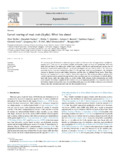Monosex culture of the mud crab Scylla serrata at three stocking densities with Gracilaria as crab shelter
- Global styles
- MLA
- Vancouver
- Elsevier - Harvard
- APA
- Help

閲覧/開く
日付
1999Page views
5,018ASFA keyword
AGROVOC keyword
Taxonomic term
Metadata
アイテムの詳細レコードを表示する
Share
抄録
The effects of three levels of stocking density (0.5, 1.5 or 3.0/m2) and monosex culture (male or female) on the growth, survival and production of Scylla serrata were investigated. Juvenile crabs were stocked in 150 m2 enclosures in earthen ponds with Gracilaria as shelter and fed a mixed diet of 75% fresh brown mussel flesh and 25% fish bycatch. There was no interaction between stocking density levels and monosex culture (P<0.05) so the data were pooled for each sex or stocking density treatment. Results showed that highest survival was obtained from a stocking density of 0.5/m2 (P<0.05). Crab growth at different stocking densities was not significantly different (P>0.05). Highest return on investment (ROI) and lowest production costs were attained from 0.5/m2. Partial budgeting analysis showed that no net benefit accrued from stocking beyond 1.5/m2. Male crabs attained significantly better (P<0.05) final weight and specific growth rate than female crabs. Length, width, survival and production between male and female crabs were not significantly different (P>0.05). Male and female monoculture gave high net revenue and ROI of more than 100 but male monoculture is more profitable. Overall the results suggest that the culture of male or female mud crabs at 0.5–1.5/m2 with Gracilaria is economically viable.
Suggested Citation
Triño, A. T., Millamena, O. M. & Keenan, C. P. (1999). Monosex culture of the mud crab Scylla serrata at three stocking densities with Gracilaria as crab shelter. In C. P. Keenan & A. Blackshaw. (Eds.). Mud Crab Aquaculture and Biology. Proceedings of an international scientific forum held in Darwin, Australia, 21–24 April 1997 (pp. 61-66). Canberra: Australian Centre for International Agricultural Research.
Type
Conference paperCollections
- Conference Proceedings [299]
Related items
Showing items related by title, author, creator and subject.
-
Development of protocol for the production of hatchery-reared mud crab Scylla serrata juveniles for soft-shell crab farming
Quinitio, Emilia T. ; Libunao, Gardel Xyza; Parado-Estepa, Fe D. (Aquaculture Department, Southeast Asian Fisheries Development Center, 2017)
Development of economically viable techniques for growing hatchery-reared juvenile crabs to suitable sizes will address the problem on the source of seed stocks for soft-shell crab farming. This paper reports the production ...
; Libunao, Gardel Xyza; Parado-Estepa, Fe D. (Aquaculture Department, Southeast Asian Fisheries Development Center, 2017)
Development of economically viable techniques for growing hatchery-reared juvenile crabs to suitable sizes will address the problem on the source of seed stocks for soft-shell crab farming. This paper reports the production ... -
Larval rearing of mud crab (Scylla): What lies ahead
Waiho, Khor; Fazhan, Hanafiah; Quinitio, Emilia T. ; Baylon, Juliana C.; Fujaya, Yushinta; Azmie, Ghazali; Wu, Qingyang; Shi, Xi; Ikhwanuddin, Mhd; Ma, Hongyu (Elsevier, 2018)
The increasing global demand for mud crabs (genus Scylla) and threats to the wild populations highlight the urgency of fully rearing them in captivity. Despite considerable progress in mud crab production, most crab farms ...
; Baylon, Juliana C.; Fujaya, Yushinta; Azmie, Ghazali; Wu, Qingyang; Shi, Xi; Ikhwanuddin, Mhd; Ma, Hongyu (Elsevier, 2018)
The increasing global demand for mud crabs (genus Scylla) and threats to the wild populations highlight the urgency of fully rearing them in captivity. Despite considerable progress in mud crab production, most crab farms ... -
Mud crab pond and pen culture
Rodriguez, Eduard M. (University of the Philippines Aquaculture Society, Inc, 2001)




